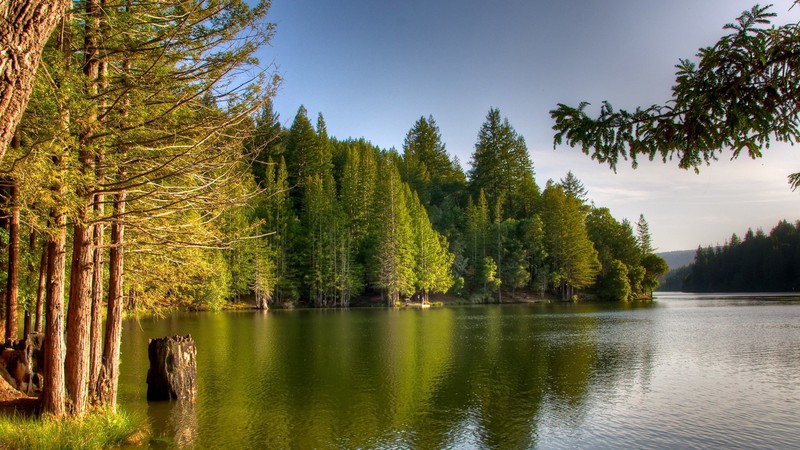
The city of Santa Cruz gets just over 20 percent of its water from Loch Lomond in the mountain community of Lompico. Don Debold CC BY 2.0
BY MATT RENDA
Santa Cruz’s relative geographic isolation makes its water-supply picture somewhat unique in California. Hemmed in by the Monterey Bay and the Pacific Ocean to the west and the Santa Cruz Mountains to the east, it is one of the few California communities that receive 100 percent of its water from local rainfall, and not via the vast and complex system of interconnected dams, reservoirs, channels and tunnels that comprise the California State Water Project and the Central Valley Project, operated by the state and the federal governments respectively.
Santa Cruz’s main source of water is the San Lorenzo River, the 29-mile river with headwaters in Castle Rock State Park in the Santa Cruz Mountains. The river provides about 47 percent of the city’s water supply.
Other sources of surface water include Majors Creek, in between Santa Cruz and Davenport; Liddell Spring, near Bonny Doon; and Laguna Creek, near Davenport. These sources together account for approximately 32 percent of the city’s water supply.
For the rest of its surface water supply, Santa Cruz relies on Loch Lomond, a modestly sized reservoir that holds 2.8 billion gallons of water, or 9,200 acre-feet.
The reservoir is located in the Santa Cruz Mountains near the town of Lompico and allows various recreational activities, including boating and fishing. Its capacity is widely considered to be insufficient to protect Santa Cruz from anticipated periods of prolonged drought.
Together, surface water accounts for 95 percent of the water supply in Santa Cruz, with the remaining 5 percent extracted from groundwater sources. There are three major groundwater sources in the county. The first, Santa Margarita Basin, is a triangular area between Felton, Ben Lomond and Scotts Valley. The second, the Mid-County Groundwater Basin, encompasses the city of Santa Cruz and the municipalities to the south, including Aptos, Capitola, Soquel, and Live Oak. The basin is currently listed as in critical overdraft. The last aquifer, the Pajaro Basin, is east of the Mid-County basin and stretches south to the Monterey County line. It provides water to the city of Watsonville.
Desal Plan Rejected and Abandoned
Recently, a protracted drought spanning from 2011 through 2017 caused Santa Cruz officials to mull options to increase its water supply, including the pursuit of a desalination plant proposed for construction on the city’s westside. The plant, which changes saltwater into potable water by extracting mineral components, was to withdraw about 5 million gallons of saltwater per day from Monterey Bay and convert it into about 2.5 million gallons of drinkable water.
In 2013 it became clear city officials were seriously pursuing the option, going so far as to launch a pilot plant at the Seymour Center’s Long Marine Lab. Many Santa Cruz residents opposed the project on environmental and scenic grounds. Recent discussions about solving the city’s persistent water supply problems have focused less on desalination as a solution and more on recycled water and other technologies. “Water reuse” captures water from a variety of sources, including wastewater, and deploys advanced technology to treat the water in such a manner that it is rendered potable.
The Santa Cruz-Soquel Water Swap
The Santa Cruz City Council enacted a five-year contract with Soquel Water District on a pilot program to deliver more surface water from the district to city customers. The deal, struck in February 2021, calls for the city to transfer about 115 million gallons of surface water to the Soquel district’s customers during the wet season to decrease the pumping of groundwater from the Mid-County Groundwater Basin.
The deal sends water back to Santa Cruz when the summer’s dry skies arrive. Santa Cruz has also considered pumping water into its fragile underground aquifers during the wet season to replenish them in advance of the summer when they are burdened by thirsty households and businesses.
The central question looming over all discussions about Santa Cruz’s water supply moving forward is whether deals with neighboring agencies that take a more holistic approach to watersheds will be sufficient to meet the region’s needs or whether the city and the surrounding jurisdictions must invest in capital-intensive projects to augment their water supply.
Long form articles which explain how something works, or provide context or background information about a current issue or topic.